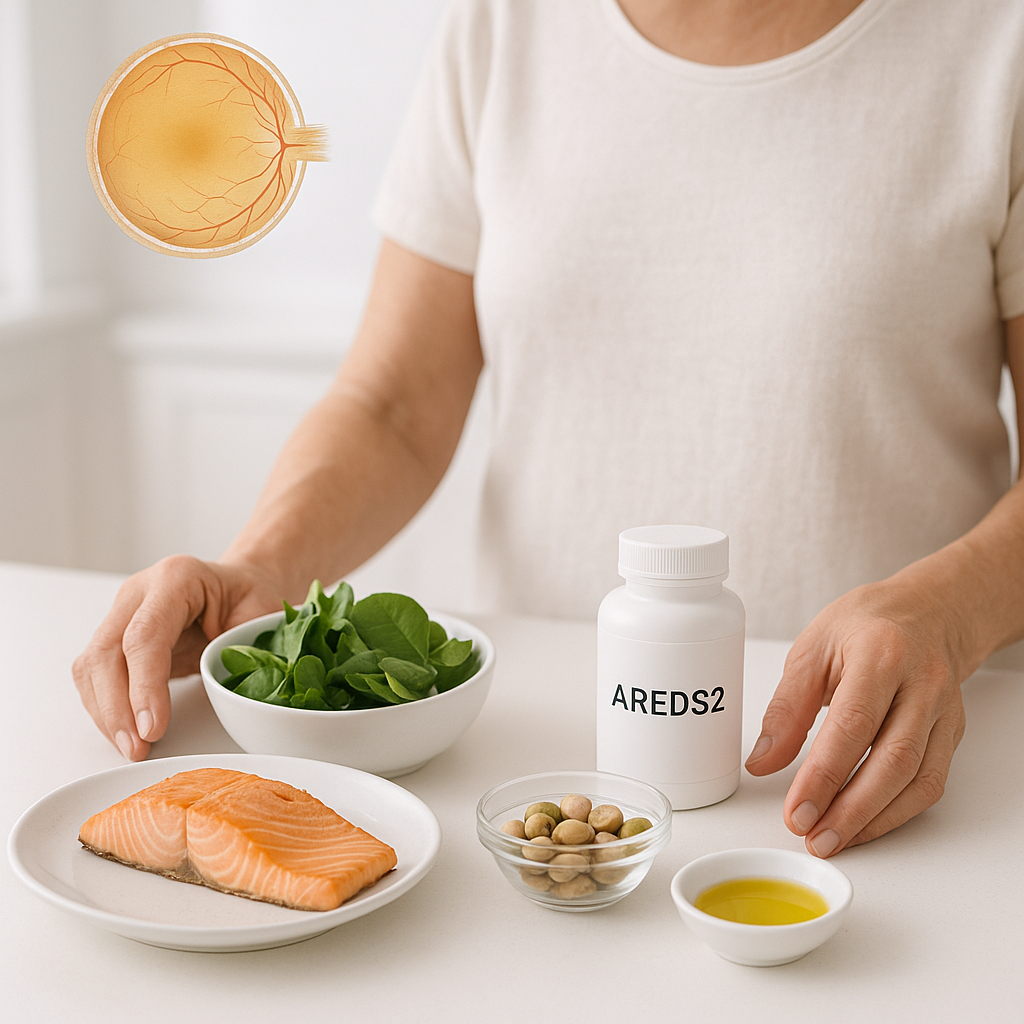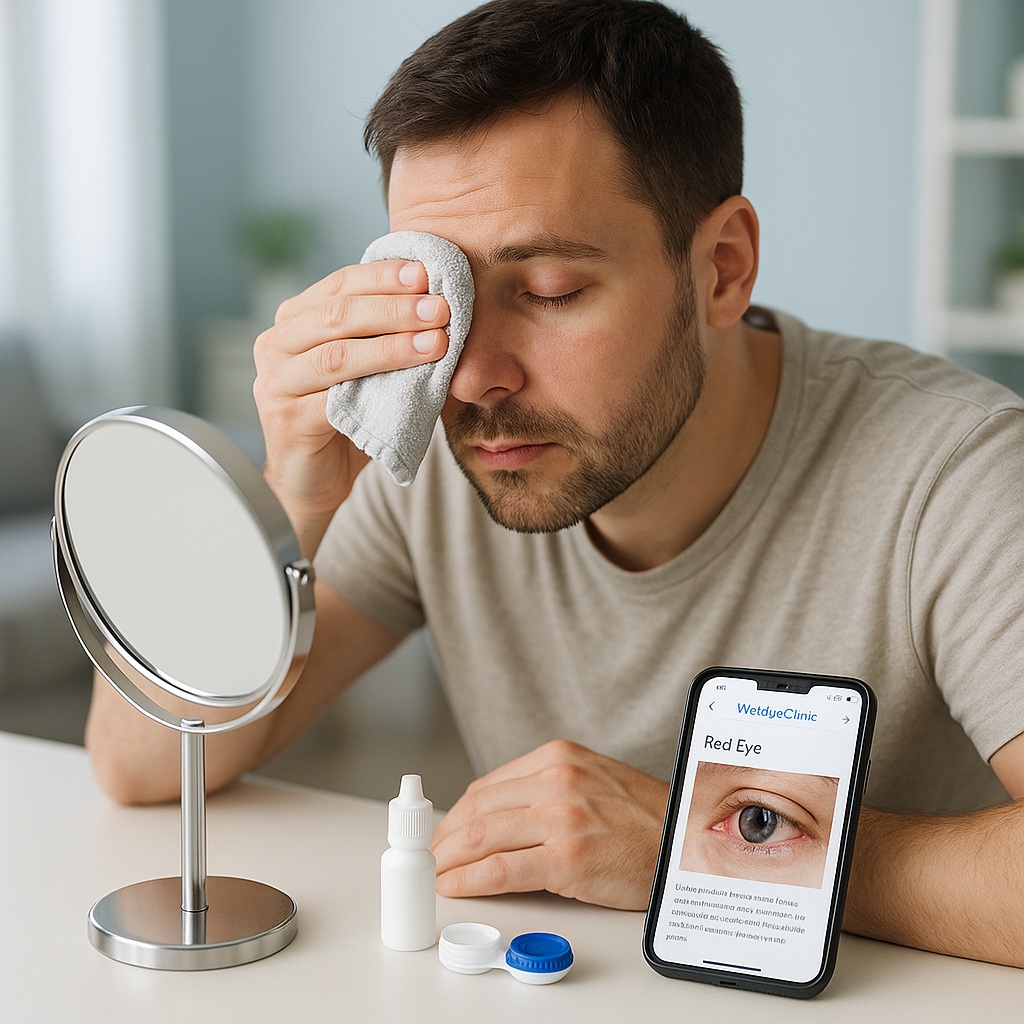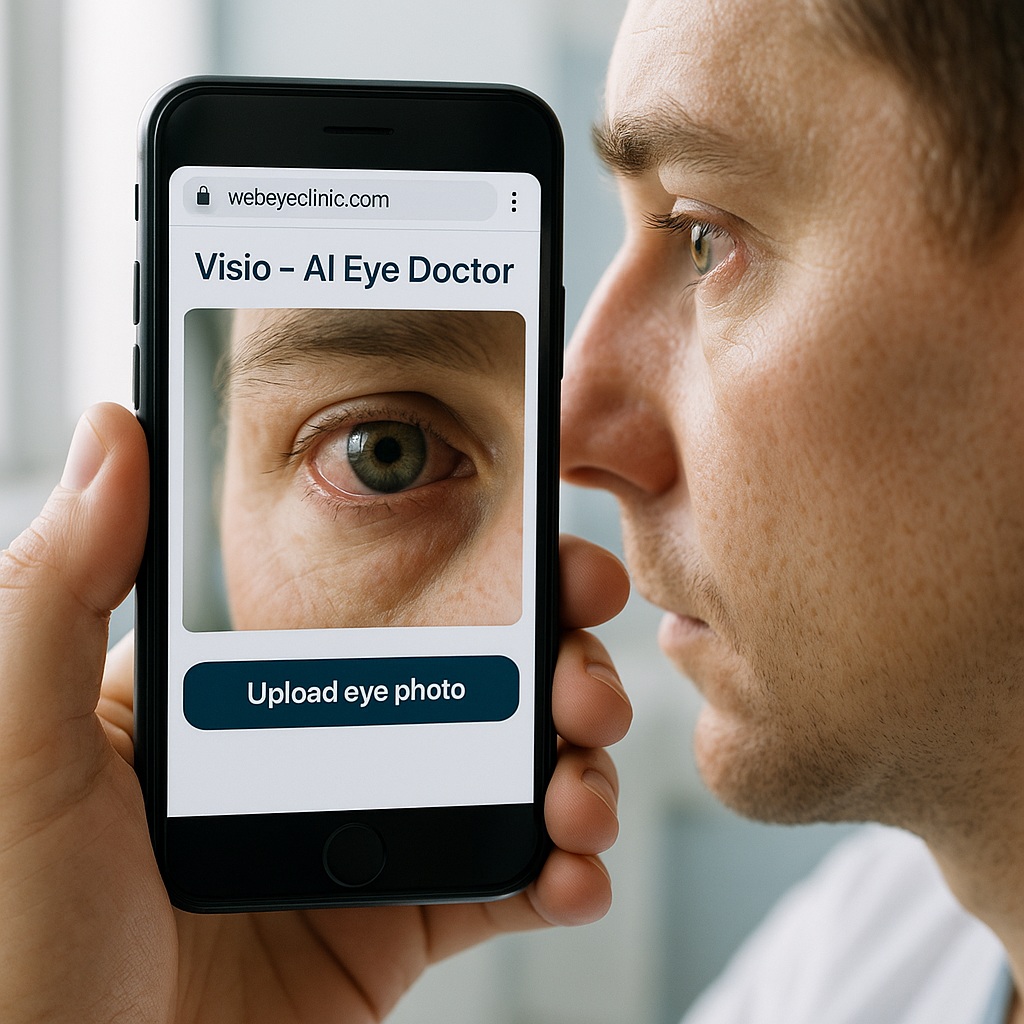Published: October 2025
This guide is written for patients living with age-related macular degeneration (AMD) and was medically reviewed by a retina specialist.
Can you slow macular degeneration naturally? Many people ask this right after they hear the words “age-related macular degeneration” (AMD). AMD is a common retinal disease that harms the macula. The macula is the small spot in the back of the eye that lets you read, drive, and recognize faces. There is no instant cure. You cannot undo years of retinal wear in one day. But new research in 2024–2025 shows that smart food choices, eye vitamins with real clinical data, and lifestyle changes can slow progression for many people. These steps can help protect the vision you still have.
What Is Age-Related Macular Degeneration?
Age-related macular degeneration is a disease that damages the macula over time. As AMD gets worse, central vision can become blurry or distorted. Colors may fade. A dark or empty spot can appear in the center of what you are looking at. AMD comes in two main forms. “Dry” AMD is more common and usually slower. “Wet” AMD is less common but more aggressive. Wet AMD happens when abnormal leaky blood vessels grow under the retina. Late dry AMD can lead to “geographic atrophy,” which means patches of retinal cells die and do not come back. AMD can take away sharp central vision, which affects reading and daily independence.
Can You Slow Macular Degeneration Naturally?
In many cases, yes. You may be able to slow macular degeneration naturally by changing diet, quitting smoking, reducing chronic inflammation, and using the right eye supplements. You cannot bring dead retinal cells back. But you can often slow future damage. Eye specialists use the AREDS2 eye vitamin formula (vitamin C, vitamin E, zinc, copper, lutein, and zeaxanthin) to help slow progression. Doctors first used AREDS2 to slow the jump from “intermediate” AMD to advanced AMD. Newer data suggests that AREDS2 may also help slow some forms of late dry AMD, including geographic atrophy. That means many people may keep useful vision for longer.
Lifestyle matters too. Smoking and a heavy “Western diet” (fried foods, processed meat, refined carbs, and sugary snacks) are linked to faster AMD changes. A Mediterranean-style diet is linked to slower AMD changes and a lower risk of severe vision loss. In some studies, people who followed this style of eating had roughly one-third less risk of advanced AMD or fast progression. In simple terms: what you eat every day can change how fast you lose central vision.
Food Strategy: The Mediterranean Pattern
The Mediterranean diet is not one special recipe. It is a pattern you repeat most days. You base meals on vegetables (especially leafy greens), colorful fruits, beans, lentils, whole grains, nuts, seeds, and olive oil. You eat fish often. You limit red meat, fried food, and processed snacks. Long-term studies link this pattern to lower AMD risk. Some analyses show up to about a 30–34% drop in advanced AMD risk or fast worsening in people who stick to it.
Why does this work? Your macula uses a lot of oxygen and is always exposed to light. That creates constant stress. The Mediterranean pattern feeds your retina what it needs to defend itself. You get antioxidants (vitamin C, vitamin E, and many plant compounds). You get healthy fats, like omega-3s from fish and monounsaturated fat from olive oil, which help calm inflammation. You also get plant pigments called lutein and zeaxanthin. These pigments collect in the macula and act like built-in sunglasses that filter harmful blue light.
If you want a “buy this, eat this” list, focus on:
- Leafy greens (spinach, kale, chard) and other colorful vegetables every day.
- Beans or lentils several times per week.
- Whole grains instead of white bread or refined pasta.
- Nuts and seeds instead of chips or sweets for snacks.
- Olive oil instead of butter or shortening.
- Oily fish like salmon, sardines, or mackerel a few times a week.
- Fruit daily, especially berries and citrus.
Pistachios and Macular Pigment
Pistachios are getting attention in eye health. Researchers asked adults to eat about two handfuls of pistachios a day. Over a few weeks, many people showed an increase in macular pigment optical density (MPOD). MPOD is a way to measure lutein and zeaxanthin levels in the macula. A higher MPOD means the “natural filter” in your central retina is thicker. A thicker filter may block more blue light and lower stress on the macula.
Why pistachios? They are one of the most lutein- and zeaxanthin-rich nuts. The same pigments that make leafy greens “good for your eyes” also live in pistachios. The study groups did not claim that pistachios cure AMD. They did show that pistachios can raise protective pigment in the macula and raise blood lutein levels. For real life, this is an easy swap: you can replace salty processed snack foods with pistachios and feel like you are doing something direct for your eyes.
AREDS2 Vitamins: More Than “Just Take a Multivitamin”
AREDS2 supplements came from large eye studies funded by the U.S. National Eye Institute. The formula includes vitamin C, vitamin E, zinc, copper, lutein, and zeaxanthin. Retina specialists have used AREDS2 for years to slow the jump from “intermediate” AMD to advanced AMD. The classic advice used to be: “These vitamins do not help much once you reach severe dry AMD.”
That advice is changing. A newer analysis showed that AREDS2 can also slow some forms of late dry AMD, including geographic atrophy. Patients who stayed on AREDS2 lost central vision more slowly, and the dead retinal patches grew more slowly, compared with people who did not take the formula. In plain language: even if you already have serious dry AMD, these vitamins may still help you hold on to the vision you still have.
Important safety note: do not grab any random “eye vitamin.” The exact AREDS2 formula matters. Older high-dose formulas that use beta-carotene are not safe for smokers or recent ex-smokers, because beta-carotene has been linked to a higher lung cancer risk in smokers. AREDS2 removed beta-carotene and replaced it with lutein and zeaxanthin for that reason. Always ask your eye doctor or retina specialist before you start high-dose supplements.
Learn more:
New FDA-approved corneal treatment news and
ask an eye doctor.
Lifestyle Risks You Can Control
Smoking is still the number one AMD risk you can change. Smokers face a much higher chance of getting AMD. They often get it earlier in life, and it can move faster. Chemicals in smoke damage the retina’s blood supply and increase inflammation. Some reports say smokers are several times more likely to reach serious AMD, and they may lose vision up to 10 years sooner than non-smokers. Quitting helps at any age. Even cutting secondhand smoke exposure helps.
Diet gives the same message. A heavy “Western” style — fried foods, processed meats, lots of refined carbs and sugar — drives inflammation and is linked to faster AMD changes. A Mediterranean style — greens, beans, nuts, olive oil, whole grains, and fish — links to slower vision loss. In short: smoking plus junk food is the worst combo for your macula. Quitting smoking and moving toward Mediterranean eating is one of the best combos to slow macular degeneration naturally.
When These Tips Are Not Enough
Lifestyle changes can help slow macular degeneration, but they cannot fix sudden vision loss. Call an eye doctor the same day if you notice a new dark spot in the center of your vision, if straight lines look wavy, or if you see a gray or missing patch when you try to read. These symptoms can mean wet AMD, which often needs urgent treatment. Do not “wait and see.”
Do not start high-dose AREDS2 vitamins on your own. The exact formula matters, especially if you smoke or used to smoke. Your eye doctor can confirm the correct version and dose for your stage of AMD.
New Trend: Personalized AMD Risk Scores With AI
Eye doctors are starting to use artificial intelligence (AI) tools to predict who will lose vision faster. These systems study high-resolution retinal scans plus personal risk factors like age and smoking. The AI then flags eyes that are likely to progress quickly toward severe AMD, such as geographic atrophy or wet AMD. If your eye sits in that “high risk” group, the clinic can act sooner. That can mean tighter follow-up, earlier talk about AREDS2 vitamins, faster referrals to a retina specialist, and urgent treatment if wet changes start. This is a shift from “come back next year and we’ll see” to “we already know you are high risk, so we protect you now.”
When You Should Call an Eye Doctor
Call an eye doctor or retina specialist right away if you notice a sudden new dark spot in the center of your vision, if straight lines look wavy, or if words in the middle of a page look blurred or missing. These can be signs of wet AMD or fast retinal damage. Wet AMD often needs urgent treatment. Waiting can lead to permanent vision loss.
Even without sudden changes, regular eye exams are critical once you have early AMD, intermediate AMD, or geographic atrophy. Modern scans can spot trouble long before you notice symptoms. Early action is almost always easier than late rescue.
Bottom Line: Build an AMD Protection Plan
You cannot erase AMD. But you can slow macular degeneration naturally in many cases. Eat in a Mediterranean style rich in leafy greens, beans, nuts (including pistachios), whole grains, olive oil, and fish. Quit smoking. Ask your eye doctor if AREDS2 vitamins are right for your stage of AMD. Keep your retina checkups. The goal is simple: protect the central vision you still have, and hold it as long as possible.
Medically reviewed by: SR, MD, Ophthalmologist (Retina Specialist).
Last updated: October 25, 2025.


